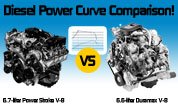More than you probably want to know about HP/torque
Again this is based on math and how HP is CALCULATED. There is no way to measure HP directly... dyno's measure TQ and calculate HP using the method I formula above.
Yes, there is a mathematical relationship between torque and horsepower. (I can derive the formula for you if you want to see where "(torque x rpm)/5252" comes from) And yes, those graphs look goofy.
But the mathematical relationship goes both ways. You can measure horsepower and calculate the torque.
Horsepower is simply a measurement of the *rate* of doing work. Someone (James Watt?) decided a long time ago that a "standard horse" (yes, the animal) attached to a harness and pulley system could lift 550 lbs of weight one foot off the ground in one second. That rate of doing work became the standard we call "one horsepower".
If the horse can lift the 550 lb weight at the rate of one foot per second, it has just achieved a one horsepower rating. If a second horse can lift the 550 lb weight at a rate of two feet per second, it is a two horsepower horse!
The second horse would have to be pulling twice as hard as the first horse to lift the same weight twice at twice the velocity... But did we need to measure that force to know the horsepower? No.
(Engines rotate and the measure of force is called torque. I don't want to get all mathematical here... but suffice to say that each 550 lb-ft of work an engine can do per second equals one horsepower.)
You can measure torque (force) and calculate HP or you can measure HP and calculate torque (force).
Brake dynos measure torque. Other types of dynos measure the rate of doing work (horsepower) and calculate the torque.
P.S. If BigJ lived in the 1800's, can't you just see him testing all the horses in town to see how fast each one could lift a 550 lb weight?
 For the first time, we present the horsepower and torque curves for both the 2011 Power Stroke and 2011 Duramax diesel engines. There's a story to be told reading between the lines.
For the first time, we present the horsepower and torque curves for both the 2011 Power Stroke and 2011 Duramax diesel engines. There's a story to be told reading between the lines.
